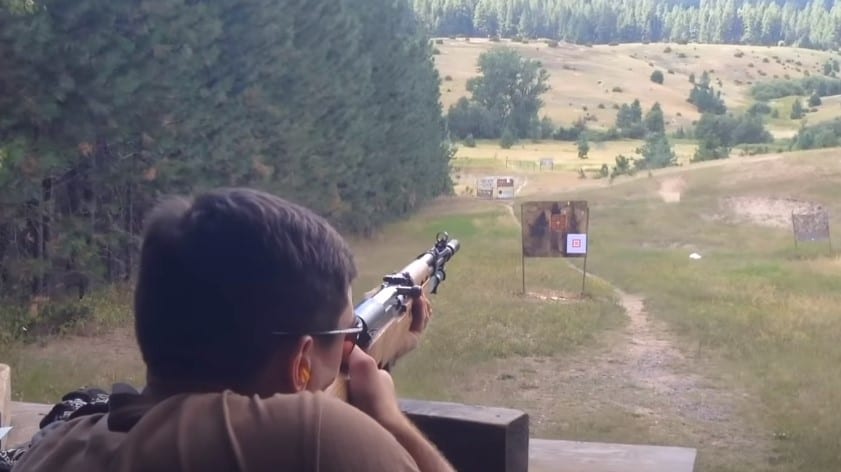Getting Started: Long-Range Shooting With Iron Sights

While optical technology and rifle scopes have been around for over a hundred years, they’ve been mostly regulated by hunters, specialized troops, and police officers. Within the last fifteen years, however, the optics industry has exploded.
Nowadays, nearly every soldier and police officer’s rifle are topped with some form of optic, be it a red dot, fixed, or variable optic.
These days the men and women in the United States Military are being taught from day one in boot camp how to use a rifle combat optic like a Trijicon Acog.
With the rise of optics, many new shooters fail to realize how capable a shooter can be armed only with a pair of iron sights.
The United States Marine Corps would regularly take people who had never fired a rifle in their lives and, at the end of three weeks have them striking targets out to 500 yards with nothing more than an M16A2 and a pair of iron sights.
The task of shooting medium and long ranges with iron sights is not as daunting as many imagine.
Let’s Get Started with Long Range Shooting with Iron Sights
It is becoming easier and easier to shoot long distances accurately and efficiently. As high-quality optics have become more common, many new shooters fail to realize how capable an iron sight can be.
It is important to consider all variables when calculating a successful shot, such as the rifle type, optics, ammunition, wind, elevation, and temperature.
You can overcome those variables quickly if you have a good set of optics. What happens if your optics malfunction? Shooting your rifle long range with iron sights is a true test of skill and engineering. Let’s get started.
1. First Thing Is To Zero the Sight!
The first step is properly zeroing a set of iron sights on the rifle. Like scopes, iron sights require their own specific distances and adjustments to properly zero.
A shooter needs to understand what style of sights they are using and how to zero their sights properly.
For example, the standard AR 15/Ma6 sights require a 25-meter range and 300 meters zero targets. This target simulates a 300-meter target at 25 yards.
Weapons with different calibers, different barrel lengths, and different iron sights all zero differently.
Regardless of the different factors, to achieve the desired performance, the shooter must follow the proper instructions for a correct zero if they plan to engage at long distances with only irons.
Proper adjustments may need to be made to the front and rear sights. These adjustments can be for both windage and elevation.
The shooters must zero the weapon themselves for the best result, and here is a great guide on how to do it on iron sights.
2. Average Iron Sight May Not Cut It!
To maximize precision, especially at ranges beyond 500 meters, you should look into specialized iron sights. For shooters looking for something simple and precise, they can replace their front sight with one that is thinner.
This allows the shooter to see the target more easily at extended ranges. Sights by companies like KNS Precision are a simple drop in modifications that allow for more precise shooting.
For iron sight shooting out to a thousand yards, a shooter may require something much more complicated. Specialized diopter and aperture sights. Sights like the Phoenix Precision top mount rear sight are extremely precise and very detailed.
The learning curve seems steep, but the payoff allows an iron-sighted shooter to engage a six-by-six target at a thousand yards.
These sights are not for your everyday rifle but specifically for extremely precise rifles, with barrels typically around 30 inches for a longer sight radius.
Like an optic, iron sights are only as good as the base it’s mounted on. So, ensure any base you decide to use is locked down tight on the rifle.
For those 1,000-yard shots, I advise you have both the sight base and sight installed by a competent gunsmith.
3. Iron Sights Vs. Modern Optics
When compared to a red dot optic, a good set of iron can be more precise. In addition, due to a vast array of adjustments that can be made on iron sights, you can engage at longer ranges with more precision.
Red dot and holographic sights are faster to get on target, but technology has not yet evolved to allow them to make long-range precise shots. Iron sights are surprisingly precise and can be extremely accurate.
The NRA high power competition is evidence of not only how precise iron sights are but how enjoyable it is to shoot long-range with iron sights. There is no better feeling than being competent enough to engage a target at 500 yards or further with a simple set of iron sights.
Summary
If you are shooting long range, you should use a steel target. In addition to the quick feedback you receive when you hit your target, there is another reason for this. Everyone enjoys the sound of a steel target pinging.
In addition, having a spotter is always a good idea. When you push the target farther and farther away, you can make adjustments more quickly.

